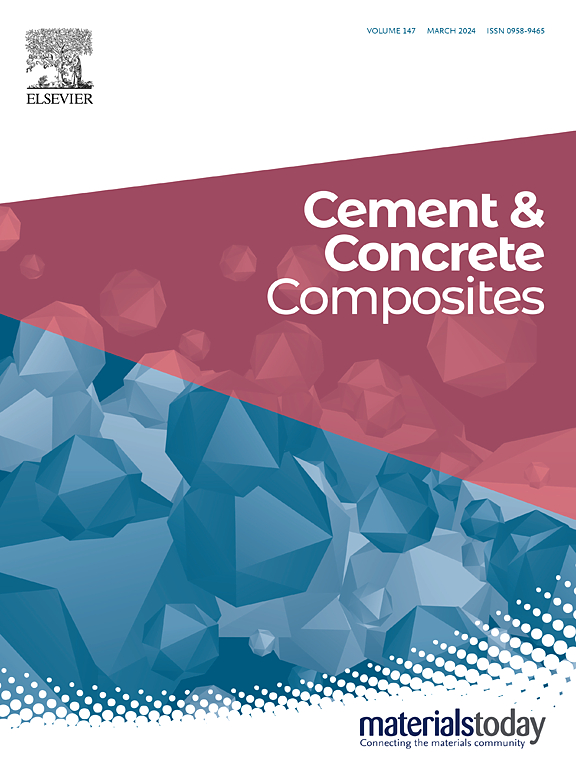Micro-scale uniaxial compression assessment of hygro-thermo-mechanical interactions in limestone-filler cement paste at low water-to-fine ratio
IF 13.1
1区 工程技术
Q1 CONSTRUCTION & BUILDING TECHNOLOGY
引用次数: 0
Abstract
The partial cement substitution with limestone filler (LF) enables the development of sustainable ultra-high-performance concrete (UHPC). While LF reduces the carbon footprint of cement production, its influence on the micromechanical behavior of cement paste under varying environmental conditions has not been fully understood. This study presents a twofold originality: first, by employing uniaxial compression on micrometer-sized specimens to characterize the mechanical properties of cement paste containing fine LF; and second, by assessing the effects of varying relative humidity (RH) and temperature (T) conditions, as an effective method of testing under rapidly archived hygro-thermal equilibrium. Moreover, a dual-method characterization approach, including water adsorption isotherms and X-ray computed microtomography (μ-CT) was employed to verify hygro-thermal equilibrium in the specimens and analyze the microstructure, respectively.
Micro-prisms (150 × 150 × 300 μm3) were fabricated using a high-precision dicing saw from cement pastes with LF additions. Micro-scale uniaxial compression tests were then conducted under controlled conditions at varying RH (10, 30, and 80 %) and T (20, 40, and 60 °C), considering their coupled effects. The increased RH and T levels generally decrease both compressive strength and elastic modulus, showing a fairly non-linear dependence. Notably, LF not only enhances compressive strength, elastic modulus, and fracture energy, but also mitigates RH and T effects, due to the refined pore structure confirmed by μ-CT analysis. This study advances the understanding of the micromechanical properties of cement paste containing LF under varying RH and T conditions at low water-to-fine ratios, providing valuable insights for the development of sustainable UHPC.
低水细比石灰石-填料水泥浆体水-热-力相互作用的微尺度单轴压缩评价
石灰石填料(LF)的部分水泥替代使可持续超高性能混凝土(UHPC)的发展成为可能。虽然LF降低了水泥生产的碳足迹,但其对不同环境条件下水泥浆体微观力学行为的影响尚不完全清楚。本研究提出了两方面的独创性:首先,通过对微米尺寸的试样进行单轴压缩来表征含有细LF的水泥浆体的力学特性;第二,通过评估不同相对湿度(RH)和温度(T)条件的影响,作为快速存档的湿热平衡下测试的有效方法。此外,采用吸附等温线和x射线计算机显微断层扫描(μ-CT)双方法对样品进行了水热平衡验证和微观结构分析。以掺入LF的水泥浆为原料,采用高精度切片锯加工成150 × 150 × 300 μm3的微棱镜。然后考虑到它们的耦合效应,在不同的相对湿度(10、30和80%)和温度(20、40和60°C)的受控条件下进行微尺度单轴压缩试验。RH和T水平的增加通常会降低抗压强度和弹性模量,呈现出相当非线性的相关性。值得注意的是,由于μ-CT分析证实了孔隙结构的细化,LF不仅提高了抗压强度、弹性模量和断裂能,而且减轻了RH和T效应。本研究促进了对低水细比下含LF水泥浆体在不同RH和T条件下的微观力学性能的理解,为可持续UHPC的发展提供了有价值的见解。
本文章由计算机程序翻译,如有差异,请以英文原文为准。
求助全文
约1分钟内获得全文
求助全文
来源期刊

Cement & concrete composites
工程技术-材料科学:复合
CiteScore
18.70
自引率
11.40%
发文量
459
审稿时长
65 days
期刊介绍:
Cement & concrete composites focuses on advancements in cement-concrete composite technology and the production, use, and performance of cement-based construction materials. It covers a wide range of materials, including fiber-reinforced composites, polymer composites, ferrocement, and those incorporating special aggregates or waste materials. Major themes include microstructure, material properties, testing, durability, mechanics, modeling, design, fabrication, and practical applications. The journal welcomes papers on structural behavior, field studies, repair and maintenance, serviceability, and sustainability. It aims to enhance understanding, provide a platform for unconventional materials, promote low-cost energy-saving materials, and bridge the gap between materials science, engineering, and construction. Special issues on emerging topics are also published to encourage collaboration between materials scientists, engineers, designers, and fabricators.
 求助内容:
求助内容: 应助结果提醒方式:
应助结果提醒方式:


